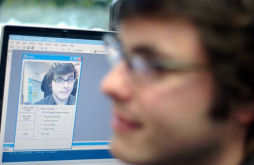A new invention could change the lives of millions of disabled people by allowing them to control a computer by raising an eyebrow.

Photo courtesy of Holdsworth Associates
Developed by Oliver Williams and Professor Roberto Cipolla from the Department of Engineering, the software will be free to download and use, providing a much-needed method of input for those unable to communicate conventionally.
The system, code named VIM (Visual Inference Machine), provides an accurate way of tracking limited facial movement. Unlike other input systems, it only requires a webcam and portable computer, providing a cheap alternative to existing systems that can cost tens of thousands of pounds.
VIM allows users with limited movement abilities to control a user interface with facial movements, such as eyebrows, eyes, or mouth. Coupled with Dasher, an invention from the Department of Physics, VIM allows severely disabled people to type and send emails at speeds close to keyboard input.
VIM's inventors have decided to make the system "open source", meaning that anybody will be able to download or use the software without restriction. They hope that its final release in a few months will make things easier for thousands of people.
The system uses a webcam and unique software developed by the team to intuitively track the movement of one face feature. It can work from most angles and in all light conditions, making it suitable for mobile use in wheelchairs. Dasher, developed by the Cavendish Laboratory's Professor David MacKay, allows users to write quickly using a simple up and down movement, making input simple with VIM.
The adaptive nature of the VIM system makes it possible to control a computer using other movements that can be tracked by a camera. The team have also adapted it to control a pointer using hand movements on a desk, which could offer relief for regular mouse users suffering from repetitive strain injury (RSI).
VIM's development has taken nearly two years but the team are in the final stages of testing before offering it to users.

